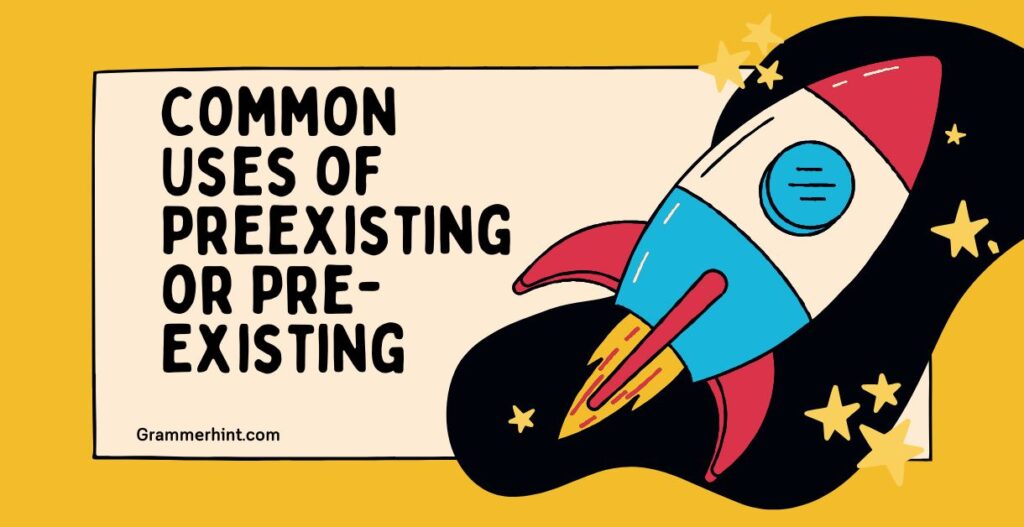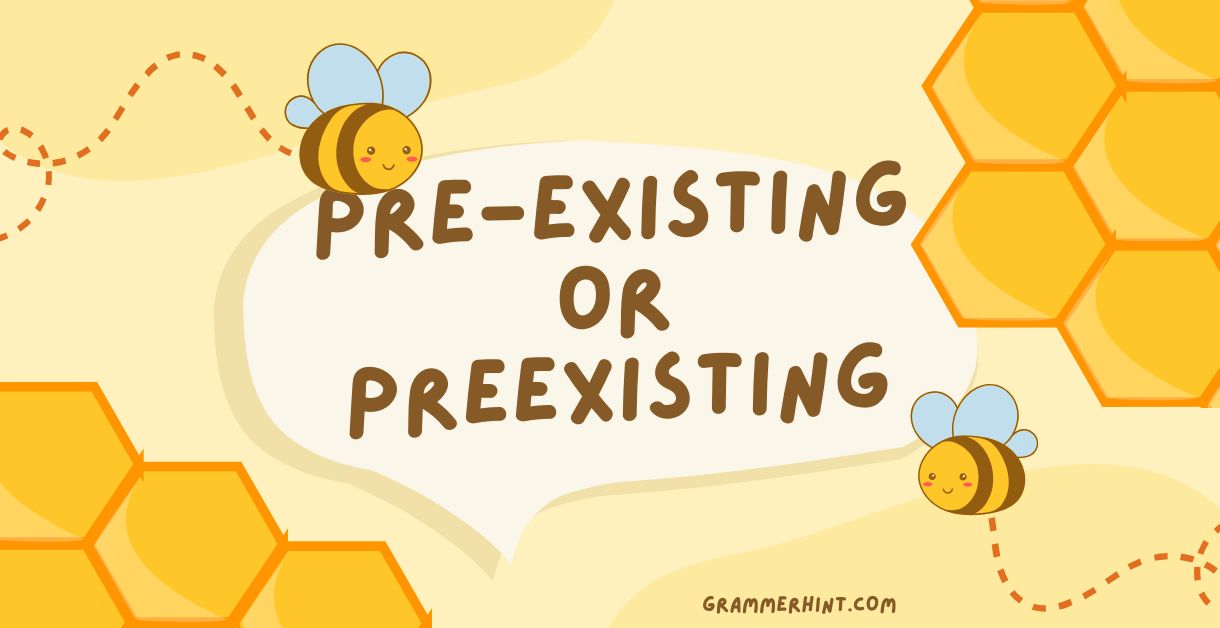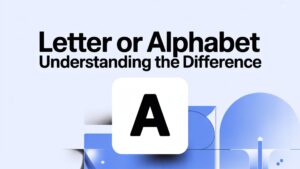When it comes to compound word rules, especially those involving prefixes like “pre-,” many writers wonder: “Should preexisting have a hyphen?” Or to phrase it more directly pre-existing or preexisting: which one is correct?
This seemingly minor question actually reflects deeper concerns about grammar and spelling, style guide recommendations, and clarity in writing.
What Does “Preexisting” Mean?
To start, let’s look at the preexisting definition. The word “preexisting” refers to something that already existed before a certain point in time.
➤ Pre-existing definition (with a hyphen):
An adjective describing a state or condition that was present beforehand.
Example: He had a pre-existing condition before applying for insurance.
➤ Preexisting definition (without a hyphen):
Identical in meaning to “pre-existing” but formatted as a closed compound.
Example: The preexisting structure must be demolished before new construction begins.
Both forms are correct, depending on the style guide you’re following, which we’ll explain in depth.
Is Preexisting Hyphenated?
The short answer: It depends. Whether you hyphenate “preexisting” often comes down to:
- The style guide you’re using (AP Stylebook vs Chicago Manual)
- The writing context (journalistic vs academic vs casual)
- Your need for clarity and readability
So, is “preexisting” hyphenated? Let’s dig into the grammar.
Grammar Rule for Preexisting: Compound Word Formation
To understand this, you need to know how compound words with prefixes are typically formed in English.
Three Common Compound Forms:
| Form | Example | Definition |
|---|---|---|
| Open compound | “ice cream” | Two separate words used as one idea |
| Closed compound | “notebook” | Two words combined without a space |
| Hyphenated compound | “mother-in-law” | Words connected with a hyphen |
The word “pre-existing” or “preexisting” is a compound word with a prefix (the prefix “pre-”) and follows different rules based on grammar guidelines.
📚 Grammar Rules for Prefixes (Like “Pre-“)
According to modern grammar rules for prefixes, hyphenation is not always necessary unless:
- The second word starts with the same letter the prefix ends with (e.g., “re-entry”)
- Clarity is at stake
- Required by a specific style guide
Preexisting or Pre-Existing? What the Style Guides Say
📖 AP Stylebook (Used in Journalism)
Correct usage: Pre-existing (with hyphen)
Example: The patient had a pre-existing medical condition before the surgery.
- AP favors hyphenating most prefix-based adjectives, especially for clarity.
📚 Chicago Manual of Style (Used in Academic and Book Publishing)
Correct usage: Preexisting (no hyphen)
Example: Researchers examined the preexisting data for anomalies.
- Chicago prefers closed compounds when no ambiguity exists.
Preexisting vs Pre-Existing in APA and Other Academic Styles
When writing for academia, you’ll often follow APA, MLA, or Chicago styles. So what’s the standard?
✍️ APA Style (American Psychological Association)
- Recommends closed compounds when there’s no confusion.
- So, preexisting without hyphen is correct in most APA papers.
Preexisting vs Pre-existing APA conclusion: Go with preexisting unless clarity demands the hyphen.
Correct Usage of Preexisting in Sentences
Here are various examples of pre-existing in a sentence (with and without the hyphen), tailored to different writing contexts:
📩 Email Example – Formal Business Context
Subject: Site Inspection Report
Hi Natalie,
The engineers reviewed the preexisting building and found structural cracks dating back several years. We recommend immediate reinforcements.
Best,
Michael Torres
Project Manager, Orion Constructions
🧾 Medical Document – Insurance Claim
The patient’s claim was denied due to a pre-existing condition that was not disclosed during enrollment.
🧑🏫 Academic Report
These results must be interpreted within the context of preexisting policies that influence behavior.
🖥️ Software Bug Report
The update inadvertently reactivated a preexisting software issue from the 3.5 version.
Common Uses of Preexisting or Pre-Existing

✔️ Pre-existing is most often used in:
- Pre-existing condition (health insurance)
- Pre-existing bug (software)
- Pre-existing medical issue
- Pre-existing building code
- Pre-existing grammar rule
✔️ Preexisting is commonly used in:
- Preexisting structure
- Preexisting policy
- Preexisting legal dispute
- Preexisting software issue
- Preexisting condition
Pre-existing vs preexisting medical term: Both are correct. Use the hyphen if your style guide calls for it.
Should Preexisting Have a Hyphen?
This depends on the writing context and style guide. Ask yourself:
- Are you writing for journalism? → Use pre-existing (AP Style).
- Are you writing for academia? → Use preexisting (Chicago/APA).
- Are you writing casual content, like a blog or email? → Choose whichever offers better readability.
Clarity in Writing and the Hyphen

Using the hyphen in pre-existing can sometimes improve clarity and readability, especially in long or technical sentences.
For instance:
“The patient’s condition was exacerbated by a pre-existing medical issue that was never diagnosed.”vs
“The patient’s condition was exacerbated by a preexisting medical issue…”
Both are acceptable, but the hyphen can offer more visual separation.
Why Do These Differences Exist? – A Look at Language Trends
The debate between hyphenated vs non-hyphenated words is part of larger language trends. Over time, English tends to:
- Move from open compound → hyphenated → closed compound
- Simplify for modern usage
- Shift based on grammar evolution and usage over time
This is why “e-mail” became “email,” and “on-line” turned into “online.” Preexisting is simply another word moving along this path.
Style Guide Recommendations: Quick Table
| Style Guide | Preferred Form | Notes |
|---|---|---|
| AP Stylebook | Pre-existing | Journalism, newspapers |
| Chicago Manual | Preexisting | Books, academic texts |
| APA Style | Preexisting | Research papers |
| MLA Style | Preexisting | Essays, literary analysis |
Always check the style guide required for your writing.
Writing Consistency: Why It Matters
When choosing between pre-existing or preexisting, writing consistency is more important than picking one over the other. If you use one version, stick with it throughout your piece.
This ensures:
- Better readability
- Writing accuracy
- Professional tone
Switching between hyphenated and unhyphenated forms can confuse readers, even if both are technically correct.
Hyphenation Rules and Grammar Mechanics
If you’re still wondering about the correct use of preexisting, here are some basic hyphenation rules for prefix-based compounds:
✅ Add a hyphen when:
- The base word is a proper noun
- The word becomes unclear or awkward without it
- Your style guide requires it
- The same vowel or consonant repeats (e.g., re-enter)
❌ Skip the hyphen when:
- The meaning is clear without it
- The compound is familiar/commonplace
- The style guide suggests a closed compound
This is part of language mechanics and how adjective-noun phrases evolve.
Spelling Variations in English: US vs UK
In US English, the tendency is toward simplification—favoring closed compounds.
In UK English, more hyphenated forms survive longer.
Example:
US: preexisting building
UK: pre-existing building
Understanding these spelling differences is key to mastering writing accuracy.
Summary: Which is Correct—Pre-Existing or Preexisting?
Here’s a final breakdown of the correct form or spelling depending on context:
| Use Case | Correct Form | Notes |
|---|---|---|
| Journalism | Pre-existing | AP style prefers hyphenation |
| Academic | Preexisting | APA and Chicago favor closed compound |
| Casual or Blogging | Either | Pick one and stay consistent |
| Legal/Medical | Both | Follow your organization’s guidelines |
🧠 Conclusion: Which Is Correct—Pre-Existing or Preexisting?
So, which is correct—pre-existing or preexisting? The answer is: both are grammatically correct, but the best choice depends on:
- Your intended audience
- Your writing context
- The style guide you’re following









